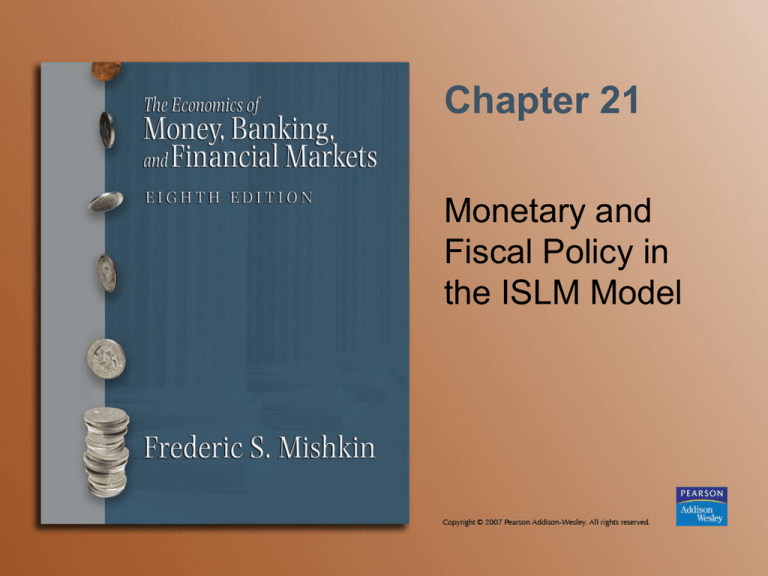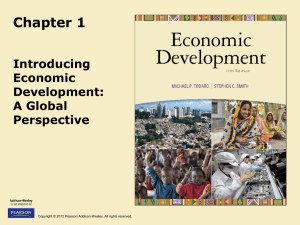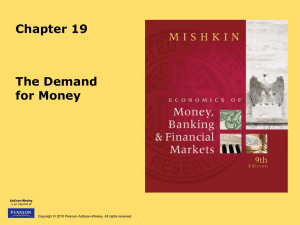
Chapter 21
Monetary and
Fiscal Policy in
the ISLM Model
Factors that Shift the IS Curve
• A change in autonomous factors that is
unrelated to the interest rate
Changes in autonomous consumer expenditure
Changes in planned investment spending unrelated
to the interest rate
Changes in government spending
Changes in taxes
Changes in net exports unrelated to the
interest rate
Copyright © 2007 Pearson Addison-Wesley. All rights reserved.
21-2
Copyright © 2007 Pearson Addison-Wesley. All rights reserved.
21-3
Copyright © 2007 Pearson Addison-Wesley. All rights reserved.
21-4
Copyright © 2007 Pearson Addison-Wesley. All rights reserved.
21-5
Factors that Shift the LM Curve
• Changes in the money supply
• Autonomous changes in money demand
Copyright © 2007 Pearson Addison-Wesley. All rights reserved.
21-6
Copyright © 2007 Pearson Addison-Wesley. All rights reserved.
21-7
Copyright © 2007 Pearson Addison-Wesley. All rights reserved.
21-8
Response to
a Change in Monetary Policy
• An increase in the money supply creates an
excess supply of money
• The interest rate declines
• Investment spending and net exports rise
• Aggregate demand rises
• Aggregate output rises
• The excess supply of money is eliminated
• Aggregate output is positively related to the
money supply
Copyright © 2007 Pearson Addison-Wesley. All rights reserved.
21-9
Copyright © 2007 Pearson Addison-Wesley. All rights reserved.
21-10
Response to
a Change in Fiscal Policy
• An increase in government spending
raises aggregate demand directly; a
decrease in taxes makes more income
available for spending
• The increase in aggregate demand
cause aggregate output to rise
• A higher level of aggregate output
increases the demand for money
Copyright © 2007 Pearson Addison-Wesley. All rights reserved.
21-11
Response to
a Change in Fiscal Policy (cont’d)
• The excess demand for money pushes
the interest rate higher
• The rise in the interest rate eliminates
the excess demand for money
• Aggregate output and the interest rate
are positively related to government
spending and negatively related to taxes
Copyright © 2007 Pearson Addison-Wesley. All rights reserved.
21-12
Copyright © 2007 Pearson Addison-Wesley. All rights reserved.
21-13
Monetary versus Fiscal Policy
• Complete crowding out
Expansionary fiscal policy does not lead to
a rise in output
Increased government spending increases
the interest rate and ‘crowds out’ investment
spending and net exports
• The less interest-sensitive money
demand is, the more effective monetary
policy is relative to fiscal policy
Copyright © 2007 Pearson Addison-Wesley. All rights reserved.
21-14
Copyright © 2007 Pearson Addison-Wesley. All rights reserved.
21-15
Copyright © 2007 Pearson Addison-Wesley. All rights reserved.
21-16
Copyright © 2007 Pearson Addison-Wesley. All rights reserved.
21-17
Copyright © 2007 Pearson Addison-Wesley. All rights reserved.
21-18
Targeting Ms versus Interest Rates
• If the IS curve is more unstable
(uncertain) than the LM curve, a Ms
target is preferable
• If the LM curve is more unstable
than the IS curve, an interest-rate target
is preferred
Copyright © 2007 Pearson Addison-Wesley. All rights reserved.
21-19
Copyright © 2007 Pearson Addison-Wesley. All rights reserved.
21-20
Copyright © 2007 Pearson Addison-Wesley. All rights reserved.
21-21
ISLM Model in the Long Run
• Natural rate level of output (Yn)
Rate of output at which the price level has no tendency
to change
• Using real values, so when the price level changes,
the IS curve does not change
• The LM curve is affected by the price level
As the price level rises, the quantity of money in real
terms falls, and the LM curve shifts to the left until it reaches
Yn (long-run monetary neutrality)
• Neither monetary or fiscal policy affects output in the
long run
Copyright © 2007 Pearson Addison-Wesley. All rights reserved.
21-22
Copyright © 2007 Pearson Addison-Wesley. All rights reserved.
21-23
Copyright © 2007 Pearson Addison-Wesley. All rights reserved.
21-24
Shifts in the
Aggregate Demand Curve
• ISLM analysis shows how the
equilibrium level of aggregate output
changes for a given price level
• A change in any factor except the price
level, that causes the IS or LM curve to
shift, causes the aggregate demand
curve to shift
Copyright © 2007 Pearson Addison-Wesley. All rights reserved.
21-25
Copyright © 2007 Pearson Addison-Wesley. All rights reserved.
21-26
Copyright © 2007 Pearson Addison-Wesley. All rights reserved.
21-27








